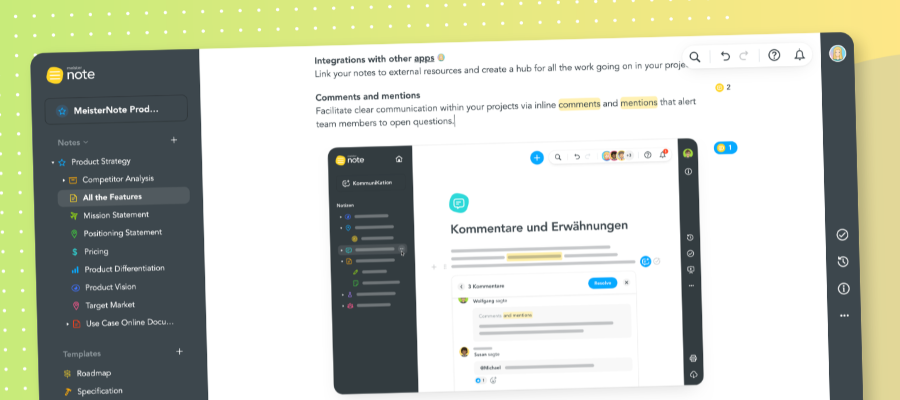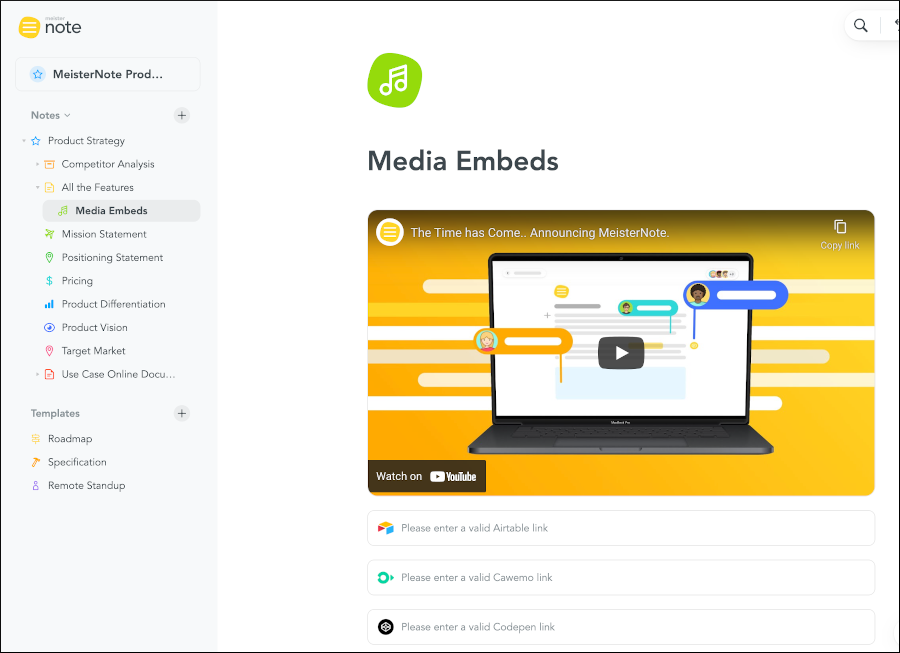
Earlier this year, Meister Labs launched MeisterNote, a new take on collaborative documentation from the talented team that has brought us MindMeister and MeisterTask. Like the other members of the Meister suite, its design is simple, intuitive and visual.
But why create a collaborative documentation tool? How does it fit into the Meister universe? What needs does it fill for busy workers?
To better understand the thinking behind it, I recently interviewed Mara Münzing, the product marketing manager for MeisterNote. What I discovered is a tool that is gaining a passionate following because it elegantly solves several common problems that organizations face today.
Chuck Frey: Why did Meister create MeisterNote? What was the vision behind it?
Mara Münzing: We had all of our internal documentation and our company handbook scattered in a number of places online, including Google Drive, Google Slides and Google Docs. No one was happy with that arrangement. It was hard for our people to find the resources they needed to gt work done. The other tools we looked at, like Notion and Confluence, were just too complex and confusing.
So we decided to build our own documentation tool, one that would be simple, intuitive and that would work together with our other tools. We did the same thing with MeisterTask – it started life as an internal tool we built for our own use to help us streamline task management.
Frey: What do people in organizations typically use to create shared documentation, and what are the shortcomings of those tools?
Münzing: From what we’ve seen, they use everything you can imagine, including Notion, Confluence, OneNote, Word documents, Google docs and other tools. Some of them have so many features or are so technical that some people get confused and frustrated. We took a look at our market research and identified four use cases. We then set out to build the essential features to support them. They are knowledge management, project documentation, internal communication and meeting management.
Frey: So what are some of the ways in which MeisterNote customers are using it to solve their documentation problems?
Münzing: One of the most interesting ones is the Catholic Diocese of Essen in Germany’s Ruhr Valley. They had been looking for a simple and intuitive knowledge management system. They started down this path by trying to implement a wiki, but found that it was too complex for some of their less technically-minded users. It failed because some people refused to use it. MeisterNote turned out to be just right for what they wanted to accomplish. Its simple, beautiful and easy to use.
In another case, a new pan-European haulage company needed a tool that would enable it to onboard new partners quickly. Before they turned to MeisterNote, they created a large handbook as a PDF file. But it was very hard for employees and partners to find the specific information they needed. With MeisterNote, they found it was easy to create informative content that is easy to navigate.
Frey: Who is the ideal user of MeisterNote by job title?
Münzing: It varies quite a bit by company and use case. First, anyone who is working on a project or who contributes to a knowledge base is an ideal user of MeisterNote. In the case of internal communications, it’s mainly the HR department and C-level people. They develop processes and policies and document them for everyone else to follow.

Frey: You mentioned that the Meister team originally developed MeisterNote for your own use. How have your internal teams benefited from it?
Münzing: One of our biggest uses of MeisterNote at Meister is for internal communication. We’ve been able to replace a lot of internal emails with MeisterNote pages. Everything that’s related to department and company updates, work processes and policies, and weekly updates from our leadership team is all in one workspace. We don’t have to search for it. It’s all in one convenient location.
One study we looked at said that employees spend something like 9.3 hours a week looking for information. Often, they don’t find it. That’s a lot of wasted hours! MeisterNote is definitely helping our team find what they need faster. It’s a real productivity booster!
We’re also using it for new employee onboarding. Our handbook and a customized onboarding plan for each new hire is stored in MeisterNote, along with the tasks they need to get done during their first weeks on the job. It’s been really nice for new hires, because it gives them a process they can follow on their own.
There’s nothing worse than starting a new job and you feel like you don’t have all the information you need. You constantly have to ask other people for help. This eliminates all of that wasted time and results in happier employees.
Not surprisingly, we used MeisterNote to plan and execute the MeisterNote product launch. Every step was documented in a workspace. We even used i to collaborate with our external PR firm.
In addition, we frequently use MeisterNote for meeting management, including publishing agendas and meeting notes. Also, we capture action items from each meeting in MeisterTask.
Frey: I’ve noticed that MeisterNote makes it easy to switch between workspaces. Is that because users need to be able to switch frequently between projects?
Münzing: Yes, but it’s important to realize that workspaces aren’t just for projects. They can also be dedicated to specific departments or operational areas within an organization. I switch between several workspaces throughout a typical work day.
This workspace approach also makes it really easy to set up and manage roles and permissions. Once they’re configured, everything in that workspace is automatically shared with that team or group.
Frey: Let’s talk about the whole idea of rich documents. Do you see a growing need to be able to embed videos, mind maps, tasks and other interactive elements into documents?
Münzing: At a fundamental level, people don’t want their information scattered in different tools. It’s faster and more convenient to have everything you need on one platform.
The other aspect of rich documents in that they make the information they contain accessible to more people. Everyone learns and works differently. Some are linear thinkers. Others are more visual. By presenting information in multiple formats, people learn and understand the information better.
I see that all the time with to-do lists. Some people love to manage them in MeisterTask. I prefer to store them as checklists in MeisterNote. Our tools can accommodate both of these preferences.

Tools like Notion, Roam and Obsidian are built around making it easy to create and link pages together into knowledge collections. Is it easy to connect pages in MeisterNote, or does that happen more at the workspace level?
Münzing: For now, you must create these page links manually. You need to create a “table of contents” page within a workspace to which you add links to the other sub-pages.
We do plan to make that much easier. Most likely, it will be a new content block type that users can add to a page and easily create a link to any other document. It’s very likely this will be visual, in the form of a small card.
Frey: So what’s the typical endpoint of a MeisterNote document? Does it get exported to another tool for further refinement or delivery, such as a Word document or a PowerPoint deck? Or does it live within MeisterNote?
Münzing: Right now, pages primarily live within MeisterNote. We view them as living, breathing documents. In a sense, they’re never really finished. You’re always adding to or embellishing them. Even after a project is finished, you may need to refer back to its documents from time to time.
Right now, you can only print or export pages to PDF. In the future, we’ll probably add several more export formats, such as CSV and HTML.
Frey: How are people using MeisterNote to present their ideas and information?
Münzing: MeisterNote’s presentation mode uses heading styles to automatically break the content of your documents into slides, which you can then scroll through using forward and back arrows on screen or via the arrow keys on your keyboard.
However, depending on how your document is structured, some slides may only have a small amount of content on them, while others may contain too much to be readable. We’re just getting started with presentation mode. We’ll be working on a solution to give users greater control over how much information is displayed in each slide.
Users of MeisterNote tell us they really love that they can present directly from it, because it eliminates the need for them to build a separate presentation in another tool like Google Slides or PowerPoint. It saves them a lot of time.
Frey: I see that MeisterNote enables document owners to roll back changes to previous versions. How important is that when teams are collaborating around a document?
Münzing: I think it’s super important. It’s a common scenario in a team environment: someone makes a change to a document, which deletes what was there before. There’s no record of it. You can’t even tell what was changed or recover it. Sometimes that happens accidentally. For collaborative documentation, it’s critical to have the capability to roll that document back to a previous version.
Frey: I see that you can access MeisterNote on mobile devices, but only in a read-only mode. When do you think users will be able to create and edit notes on tablets and smartphones?
Münzing: That’s a great question. It’s super-important to me, because I like to take notes when I’m on the go. Right now, I record hem in Apple Note, send them to myself visa Slack and then copy and paste them into MeisterNote. I know that this is an issue for many people. It’s something we’re going to be working on in 2022.
Frey: I’m the same way – I often dictate ideas on the fly into Evernote, and then develop them later on my laptop.
Is there anything else my readers should know about MeisterNote and what makes it unique or valuable?
Münzing: We’ve succeeded in creating a tool that is is simple, intuitive and beautifully designed, which many people love to use. And we have big plans for next year.
For example, one area we plan to address is external sharing – enabling people who are not part of a workspace to view or contribute to it in a limited, controlled way. Visual thinking tools like Miro and Mural have popularized that type of collaboration, and it’s something we plan to support.
We’re also looking at some improvements to note structure and navigation. As you know, everything in MeisterNote documents is composed of content blocks. We’re going to take a closer look at how they interact with each other, how they can be shared and much more.
A basic MesiterNote account is free. It’s a great way to explore this tool to see if it’s right for you. A Pro account, which gives you an expanded number of workspaces, a longer roll-back history and higher limits on the size of multimedia embeds, is only US$5.99 per month. You can learn more about MeisterNote on the application’s website.

Leave a Reply